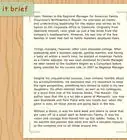This article was co-authored by Stephanie Wong Ken, MFA. Stephanie Wong Ken is a writer based in Canada. Stephanie's writing has appeared in Joyland, Catapult, Pithead Chapel, Cosmonaut's Avenue, and other publications. She holds an MFA in Fiction and Creative Writing from Portland State University.
There are 13 references cited in this article, which can be found at the bottom of the page.
wikiHow marks an article as reader-approved once it receives enough positive feedback. In this case, several readers have written to tell us that this article was helpful to them, earning it our reader-approved status.
This article has been viewed 156,750 times.
People choose to write about their lives for a variety of reasons, including a desire to leave a memoir for their children and future generations, to create a record for themselves so they can be reminded of their youthful adventures when they're old and forgetful, and to offer something of value to the rest of the world. Writing a memoir is a very personal experience, but if you're willing to share your life story, it can be incredibly rewarding.
Steps
Preparing to Write
-
1Understand the memoir genre. In a memoir, you are the main character of your own life story. Many memoirists use the facts of their life story to create an engaging tale for the reader. Because you are relying on your own memories as source material for the story, you may end up describing things differently than others might remember it. The key is to write down things as you remember it, in the most honest way possible. Keep in mind memoirs are different from autobiographies in that memoirs should only cover certain key aspects of your life, not your life from birth until the present day.[1]
- Most memoirists struggle to begin their life story and are not sure where to start. Depending on your life story, you may reach out to other family members for details on a childhood memory or event. But it’s important that you also focus on your personal experiences and your recollection of a childhood memory or moment, even if it may be flawed. Often, the best memoirs are about the process of remembering an event, or are about processing a moment in the past that felt important.
-
2Read examples of memoir. There are several good examples of memoir, some of which are considered classics of the genre:[2]
- Speak, Memory by Vladimir Nabokov. Nabokov is a highly regarded fiction writer, but one of his most celebrated works is his memoir of his childhood in Russia. The book is a good example of using literary prose and masterful storytelling to share a personal history.
- The Year of Magical Thinking by Joan Didion. Didion’s memoir focuses on the sudden death of her husband and the death of her adult daughter a few months later. This is a great example of using memory to inform the present, which for Didion, is colored by extreme grief and a sense of mortality.
- Maus by Art Spiegelman. This is a graphic novel that uses animals to tell Spiegelman’s father memories of being imprisoned in a concentration camp during the Holocaust. Spiegelman’s use of animals in fact makes the memoir feel that much more universal and relatable.
- The Woman Warrior by Maxine Hong Kingston. Kingston’s memoir of growing up as a Chinese immigrant in California combines myth, legend, and memory. Another good example of using different writing styles or approaches to write about your own life.
Advertisement -
3Analyze the examples. Choose one to two examples and read through them. Ask yourself several questions:
- Why did the author choose to highlight certain events in their life in the memoir? Consider why the memoirist chose a certain section of their childhood or a specific life event as the focus of the book. For example, Didion’s book The Year of Magical Thinking focuses on the recent deaths of her husband and her daughter, while Nabokov’s Speak, Memory focuses on his childhood in Russia. One event is in the recent past while one event is in the very distant past. Yet both events have a very strong, and possibly traumatic, effect on the writers.
- What were the narrator’s desires in the memoir? What was motivating the narrator to share this particular story with the reader? Often, memoirs can be cathartic for the writer. Perhaps the writer was trying to process a year of grieving and loss, as Didion does in The Year of Magical Thinking, or perhaps the writer was trying to describe a childhood in a concentration camp, as Spiegelman does in his memoir Maus. Consider the motivations of the writer for putting down their story and presenting it to readers.
- How did the memoir keep the reader engaged and interested in the story? The best memoirs are honest and unflinching, with details or admissions that the writer may be afraid to make. The writer may write in a way that feels truthful, full of moments that may not make the writer look good or conflicted. But readers often respond to vulnerability in a memoir, and a writer who is not afraid to describe their failures along with their successes.
- Were you satisfied with the ending of the memoir? Why or why not? Unlike an autobiography, a memoir does not need to have a linear beginning, middle, and end. Most memoirs end without any firm conclusions or end of life moments. Instead, memoirs may end with thoughts on a running theme throughout the book, or with reflections on the pivotal event or moment in the writer’s life.
Structuring Your Story
-
1Identify your narrator’s desire line. In your memoir, your narrator is you. You will use the first person, “I”, to lead the reader through your story. But it’s important to focus your memoir on specific need or desire. Your want will drive the food forward and make your story worth reading. Think about your desire line, or what motivates your narrator to tell her story. Your narrator will then struggle to achieve her desire line through telling her story and reaching a realization about a pivotal moment in her story.[3]
- Try to sum up what your narrator wants in one sentence. For example: I wanted to understand my mother’s decision to move our family to America. Or, I wanted to become healthier after a brief brush with death. Or, I wanted to explore my experiences as an air force pilot in World War II.
- Be specific in your desire line and avoid vague statements. Your desire line may change as you write your memoir. But its good to have a clear desire in mind before you start writing.
-
2Determine the key actions and obstacles in your story. Once you have a sense of what desire or want you want to explore in your memoir, you can identify the actions and obstacles your narrator must overcome to achieve the desire line. Obstacles or challenges will give the story stakes and motivate your reader to keep turning the pages of your memoir. You are the driver of the action in your story and a story isn’t very exciting if it doesn’t have any driving action.[4]
- Try to write your actions and obstacles in short sentences: To get my desire line, I did this action. But then an obstacle got in my way. So, I did this action to overcome this obstacle.
- For example: To understand why my mother moved my family to the United States, I tried to track down my mother’s family in Poland. But then I couldn’t locate my mother’s family due to poor records and missing relatives. So I went on a trip to Poland to better understand my mother and her family.
-
3Outline the inciting incident and the ending incident. Often, writers have a difficult time to determining how to start a story. A memoir can be even more challenging as you might feel you have so many details and scenes you could start with or that feel important. One way to start is to identify the inciting incident in your story and the ending incident. You will need to dramatize your inciting incident and your ending incident in your book.[5]
- The inciting incident is the pivotal moment in your story, where you realized your desire line. It could be a seemingly small moment, such as a brief fight with your mother, that becomes a major moment or inciting incident in your story. For example, your brief fight with your mother could be the last time you speak to her before she passes away and leaves you letters about her life in Poland. Think of the ah ha moment in your story when you realized what you wanted in your life, or where you realized you were wrong about your assumptions about a specific moment or event.
- The ending incident is the moment when you achieve your desire line or want. It will also help you develop an ending for your book. It could be when you discover your mother’s reason for leaving her homeland, for example.
-
4Create a plot outline. Though you are writing a memoir, following the principles of fiction, such as a plot outline, can help give your book form and shape. It can also make it easier for you to organize your research materials in a way that is engaging and interesting for your reader. A story’s plot is what happens in the story and the order it happens in. For there to be a story, something has to move or change. Something or someone goes from point A to point B due to a physical event, a decision, a change in a relationship, or a change in a character or person. Your plot outline should include:[6]
- A story goal: The plot of any story is a sequence of events that revolve around an attempt to solve a problem or attain a goal. The story goal is what your narrator wants to achieve or the problem she wants to resolve, or her desire line.
- The consequence(s): Ask yourself, What disaster will happen if the goal is not achieved? What is my protagonist afraid will happen if she doesn’t achieve the goal or solve the problem? The consequence is the negative situation or event that will result if the goal is not achieved. The combination of goal and consequence creates the main dramatic tension in your plot. It’s what makes the plot meaningful.
- The requirements: These are what must be accomplished to achieve the goal. Think of it as a checklist of one or more events. As the requirements are met in the course of the novel, the reader will feel the narrator is getting closer to attaining the goal. Requirements create a sense of anticipation in the reader’s mind, as he looks forward to the narrator’s success.
-
5Conduct basic research. Depending on your story, you may feel you need to do in-depth research on a certain subject, like air force pilots in WWII or life in a refugee camp in Poland. However, resist doing too much research before you start your first draft. You may get overwhelmed by the amount of information you come across during your research and start to forget your personal take on the facts. Remember that your memoir should focus on your memory of the event, rather than be purely factual or completely accurate.[7]
- You can conduct online research and use libraries, archives and record offices, newspapers, and microfilm.[8]
- You may also interview “witnesses to events”. This means individuals who can share first person accounts of an event. You will then need to follow up on leads, interview people, transcribe interviews, and read a lot of material.[9]
Writing the Story
-
1Make a writing schedule. This will help you determine how long it is going to take you to write a draft of the book. If you are working under a deadline, you may make your schedule more tight than if you have the luxury of more time to write.[10]
- Try to organize your schedule around word count or page count. So, if you normally write about 750 words an hour, factor this in on your schedule. Or if you feel you may actually write two pages an hour, use this as an estimate in your schedule.
- Determine how long it will take you on average to compose a set number of words, or number of pages, per a day. If you are working towards a final word count goal, like 50,000 words or 200 pages, focus on how many hours per a week it will take you to reach this goal.[11]
-
2Write a rough first draft. You may feel pressure to write and rewrite every sentence you put down. But part of writing a memoir is writing an honest account of a pivotal event, in your own words and with your own style. Avoid putting on a “writer” voice. Instead, don’t be afraid to write like you speak or talk. Include slang and any regional vernacular. Make your story sound like it is coming directly from you.[12]
- Use your plot outline to get a general sense of where your writing might be heading. But let yourself explore scenes in your rough draft. Don’t worry about writing perfect sentences or scenes. Instead, use your memory to create moments that feel true to you.
-
3Avoid the passive voice. When you use the passive voice, your writing will end feeling long winded and dull. Look for signs of the passive voice by circling all the “is” “was” and other passive verbs like “begin” “have” “seems” and “appears” in the manuscript.
- Use your grammar check (or an app like Hemingway app[13] ) to count the number of passive sentences in your manuscript. Aim for 2-4% maximum.
-
4Stick to informal language, unless it’s absolutely necessary to use formal terms. Instead of “utilize” you can just put “use”. Focus on simple language, with one or two syllable words. The only time you should be using higher level language is if you are using scientific terms or describing a technical process. Even then, you should be writing for the average reader.
- It may help to identify the reading level of the ideal reader of your book. You can determine the reading level based on the grade level of your ideal reader. If you account for ESL readers, you should aim for a grade 6 or 7 reading level. If you are writing for a higher education audience, you may write at a grade 8 or 9 level. You can use the Hemingway app to determine the reading level of your draft, or other online reading level tools.[14]
-
5Show, don't tell. Engage your reader by showing them a specific process or scene, rather than narrate directly to them. For example, write a scene that shows the reader how you discovered your mother’s letters from her family in Poland after her death. This will give the reader key information to help move the story forward, without telling them in a long, uneventful passage.
-
6Read the manuscript out loud. Find a few sympathetic ears (friends, colleagues, a writing group) and read sections of the manuscript out loud. Good writing should engage readers as listeners, with details and description that create visceral images and a strong narrative.[15]
- Don't try to impress your listeners or put on a "reading voice". Just read a natural, slow way. Ask for a reaction from your listeners after you finish reading. Note if there were sections that felt confusing or unclear to your listeners.
-
7Revise the manuscript. If you are planning to send out your memoir to publishers, you need to edit the manuscript. You may want to hire a professional proof reader to give the book a good once over for common errors or mistakes.[16]
- Don't be afraid to cut at least 20% of the material. You can likely get rid of certain sections that go on for a bit too long and cause the reader to tune out. Don't be shy about cutting chapter sections or pages that may be deadweight.
- Note if each scene in your book uses the power of the senses. Are you engaging at least one of the reader's senses in each scene? The power of enhancement through the senses (taste, touch, smell, sight, and hearing) is a trick both nonfiction and fiction writers can use to keep the reader interested.
- Check the timeline of the book. Did you follow your desire line all the way through to the end of your book? Does the ending of your book leave the reader with a sense of closure or achievement?
- The sentence level. Check for the transitions between paragraphs, are they smooth or jumpy? Look for any overused adverbs or terms and replace them so the sentences don't start to feel redundant.
Community Q&A
-
QuestionHow do I start writing about my own life?
 Community AnswerStart with the earliest thing you can remember, or with whatever you feel the most life-changing experience or relationship you've had is.
Community AnswerStart with the earliest thing you can remember, or with whatever you feel the most life-changing experience or relationship you've had is. -
QuestionDo I put certain issues of my life when writing my own life story?
 Aminat Okonu-ibrahimCommunity AnswerYes, be sure to include some of your life obstacles and how you overcome them.
Aminat Okonu-ibrahimCommunity AnswerYes, be sure to include some of your life obstacles and how you overcome them.
References
- ↑ http://www.slate.com/articles/double_x/roiphe/2013/01/bad_memoir_writing_rules_for_doing_it_well.html
- ↑ http://flavorwire.com/320083/10-of-the-best-literary-memoirs-of-all-time/4
- ↑ http://www.writersdigest.com/writing-articles/by-writing-goal/improve-my-writing/elements-of-an-effective-arc
- ↑ http://www.writersdigest.com/writing-articles/by-writing-goal/improve-my-writing/elements-of-an-effective-arc
- ↑ http://www.writersdigest.com/writing-articles/by-writing-goal/improve-my-writing/elements-of-an-effective-arc
- ↑ http://www.how-to-write-a-book-now.com/plot-outline.html
- ↑ http://www.huffingtonpost.com/lj-charleston/how-to-write-memoir_b_7853654.html
- ↑ http://www.writersdigest.com/online-editor/8-ways-to-prepare-to-write-your-nonfiction-book-in-a-month
- ↑ http://www.theguardian.com/books/2010/mar/20/thirties-intimate-history-juliet-gardiner
- ↑ http://www.writersdigest.com/online-editor/8-ways-to-prepare-to-write-your-nonfiction-book-in-a-month
- ↑ http://goinswriter.com/tips-writing-book/
- ↑ https://theamericanscholar.org/how-to-write-a-memoir/#.VcQ7AEJVikp
- ↑ http://www.hemingwayapp.com/
- ↑ https://readability-score.com/
- ↑ http://quentinschultze.com/tips-1-5-for-book-writers/
- ↑ http://www.writersdigest.com/online-editor/what-to-look-for-when-editing-your-manuscript
About This Article
To write a captivating story about your own life, read autobiographies and memoirs to help you understand how to structure your own story. When you’re ready to start writing, think about the major goals and motivations that define your life story, such as your desire to connect with your family or your goal of becoming a great writer. From there, consider some of the key events of your life and some of the obstacles you’ve faced. You can use these building blocks to start outlining your plot. Scroll down for more tips from our Writing co-author, including how to draft and polish up your manuscript!











































































